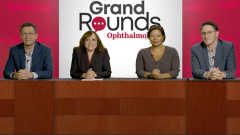
Approaches to Treating nAMD With PED
The expert panel discusses what constitutes treatment failure in anti-VEGF therapy for nAMD and examines how various treatments may yield varying results in managing PED.
Arghavan Almony, MD: Thank you for that great case. Adrienne, can you talk a little bit about how you choose the medication you’re going to use? You started with aflibercept in this patient, [then] you switched to faricimab. What do you go through when deciding what to start with, and when do you decide to switch?
Adrienne Scott, MD: My treatment rationale is made in consultation with the patient. Generally speaking, I want to give the patient the agent I feel will give them the best maintenance or improvement in their vision while having the least burdensome treatment regimen. I usually start with first-line aflibercept because I feel like it gives me those things. This case actually started before faricimab was available to us. Unfortunately, we are also at the mercy of payer constraints, so if the patient…does have authorization from the payer, I will start with aflibercept. During the time I was treating the patient, faricimab did [enter] the market, and I was very eager as soon as I could get access to try faricimab in this patient. That was largely driven by his high treatment burden. I would treat him every 4 weeks with the aflibercept and he would still show active or even increasing agitation. I wanted an agent that I felt could hold the agitation down as much as possible and give us the best chance of having an extension and treatment interval. Even now, he still has to be treated every 4 weeks with faricimab.
Arghavan Almony, MD: This is a great case because this is a patient [who is] highly motivated; they’re coming in every 28 days, you’re not having lost to follow-up, and all the other things we deal with on a day-to-day basis with our patients. Carl, what constitutes treatment failure for you when you’re treating with a drug for wet AMD [age-related macular degeneration]?
Carl Danzig, MD: There’s treatment failure and there’s suboptimal treatment. If someone is getting monthly injections with bevacizumab, ranibizumab, [or] aflibercept, I feel that’s a patient [whom] we should switch to faricimab for dual pathway inhibition in hopes we can have better durability for this patient. Have they failed? [In] this patient, yes, because they were at an expanding PED [pigment epithelium detachment] subretinal fluid in the face of Q4-week aflibercept. But even in a patient [who] may have been stable at Q4-week aflibercept, I would have switched anyway because of the suboptimal response, and you want better durability. So, here’s a patient who had worsening condition—they switched [and] the PED improved, the subretinal fluid improved, and, in hopes that with cataract surgery, the patient’s vision can improve, too.
Arghavan Almony, MD: Roger, one of the interesting points about this case was that the patient had a stroke 3 hours after they received an injection. Do you regularly talk to your patients about stroke and cardiovascular risks?
Roger Goldberg, MD: When we first are diagnosing a patient with wet AMD and talking about the injections, we’re giving them so much information all at once. To be honest, when I think about the rank order of priorities of what I’m trying to communicate and I know the patients will only remember in that first visit, which is usually when I like to give the first injection, particularly in wet AMD, I know they’re only going to remember a few things. It’s certainly part of our informed consent process. We’re giving them a handout that has all the details around injections and risks associated with injections. Do I always verbalize specifically around risks around heart attack and stroke? I’ll be honest, I don’t. The more interesting question is: If you have a patient who’s had a recent heart attack or stroke and they need injections, what is that conversation like? The way I often frame it is that there might be a very small increased risk associated with intravitreal drug delivery of these anti-VEGF agents, but the risk of not treating these patients, particularly longer than whatever—maybe you wait a month or 2 to bridge the period when they’re in postacute stroke, if you can—of significant vision loss is quite high, particularly in this case. When we think about treatment failure—like here you’re giving every 28-day injections—this patient is clearly doing worse and is at very high risk. If you were to stop treating or withhold treatment for a long period of time, I’d be very worried about that. So, it’s a conversation around risk-benefit, and I think the risk of stroke and heart attack is very low and the risk of vision loss by withholding treatment is very high. You can think of vision loss almost like it’s a stroke of a vital organ—if you go blind in 1 eye because you’ve been withholding treatment. It’s not an insignificant outcome but it’s definitely a conversation to be had.
Arghavan Almony, MD: Thank you. One of the beautiful things about this case was that we’re not just looking at wet AMD but also the PED factor. Adrienne, would you say you have noticed different responses to PEDs from different medications?
Adrienne Scott, MD: It’s a great question. I feel as though this patient’s PED is particularly striking and that the height of the PED in itself just with natural history puts him at risk for [PED] rip, so he could have sudden loss of vision…despite anti-VEGF therapy. [With] that said, I have been impressed with some of the data about faricimab and its response of [PED], and I wonder [whether] the Ang2 [antiangiopoietin 2] pathway inhibition is somehow implicated in some sort of anatomic response and improvement in PEDs.
Arghavan Almony, MD: Yes, I think we will be seeing some data on that to come.
Transcript is AI generated and edited for clarity and readability.
Newsletter
Don’t miss out—get Ophthalmology Times updates on the latest clinical advancements and expert interviews, straight to your inbox.















































.png)


